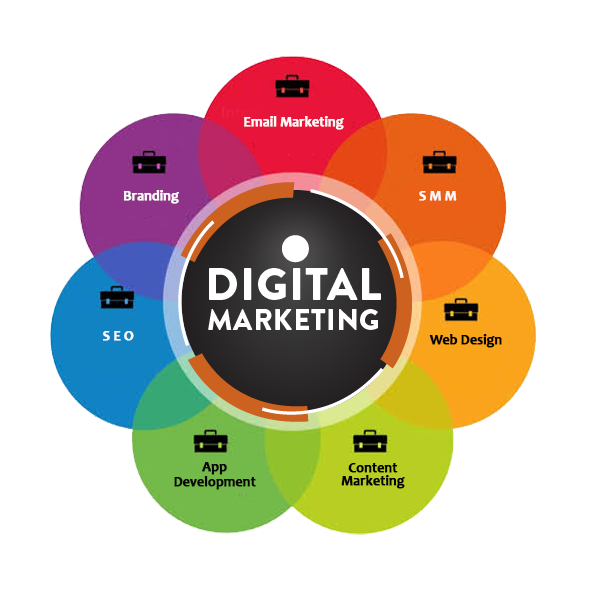Digital marketing involves using online platforms and digital tools to promote businesses, products, or services. It encompasses various strategies aimed at reaching potential customers through digital channels like search engines, social media, email, websites, and mobile apps. Key components of digital marketing include:
- Search Engine Optimization (SEO): Enhancing website visibility on search engines like Google by improving rankings for relevant keywords.
- Pay-Per-Click (PPC) Advertising: Paid ads that appear at the top of search engine results or on social media platforms, where advertisers pay each time a user clicks on the ad.
- Social Media Marketing (SMM): Promoting brands and engaging with customers through social media platforms such as Facebook, Instagram, LinkedIn, and Twitter.
- Content Marketing: Creating and distributing valuable content (blogs, videos, infographics) to attract and retain a target audience.
- Email Marketing: Sending targeted emails to prospects and customers to promote products, offer discounts, or share news and updates.
- Affiliate Marketing: Partnering with other businesses or individuals (affiliates) who promote your products or services for a commission on sales.
- Conversion Rate Optimization (CRO): Optimizing a website to increase the percentage of visitors who complete a desired action (e.g., making a purchase).
A digital marketing strategy is a plan that outlines how a business will achieve its marketing goals using digital platforms and tools. It involves identifying target audiences, setting goals, and implementing tactics to engage, convert, and retain customers. Here’s a step-by-step approach to developing a successful digital marketing strategy:
1. Define Clear Goals
Start by outlining the business objectives you want to achieve through digital marketing. These could include:
- Increasing brand awareness
- Generating more leads
- Boosting sales
- Driving more traffic to the website
Your goals should follow the SMART framework: Specific, Measurable, Achievable, Relevant, and Time-bound.
2. Identify Your Target Audience
Understand who your ideal customers are by analyzing demographic data (age, gender, location, income), psychographic data (interests, lifestyle, values), and behavioral data (purchase habits, online activities). Tailor your messaging to resonate with this audience.
3. Conduct Competitor Analysis
Study your competitors’ digital marketing tactics, identify what works well for them, and find areas where you can differentiate your brand. This can include SEO strategies, content creation, social media presence, and paid advertising.
4. Choose the Right Digital Channels
Select the platforms that align with your audience’s behavior and your business goals. These could include:
- SEO for organic search visibility
- PPC ads for paid traffic (Google Ads, Facebook Ads)
- Social media marketing for brand engagement (Facebook, Instagram, LinkedIn, etc.)
- Email marketing for nurturing leads
- Content marketing for building authority and driving organic traffic
5. Create Engaging Content
Develop a content plan that focuses on providing value to your audience. Content types may include blog posts, videos, infographics, e-books, webinars, and podcasts. The content should be optimized for SEO to increase its visibility in search engines.
6. Implement Marketing Automation
Use tools like HubSpot, Mailchimp, or Marketo to automate marketing tasks like email campaigns, lead generation, and social media posting. Automation helps improve efficiency and ensures timely communication with your audience.
7. Monitor and Optimize
Continuously track the performance of your digital marketing efforts using analytics tools like Google Analytics, social media insights, and conversion tracking. Analyze key performance indicators (KPIs) such as website traffic, lead conversion rates, and return on investment (ROI). Use this data to adjust your strategy as needed.
8. Experiment and Innovate
Always be open to experimenting with new tactics, such as A/B testing for ads, exploring new platforms, or introducing new content formats like live videos or interactive quizzes.


